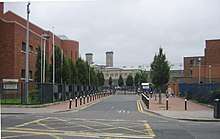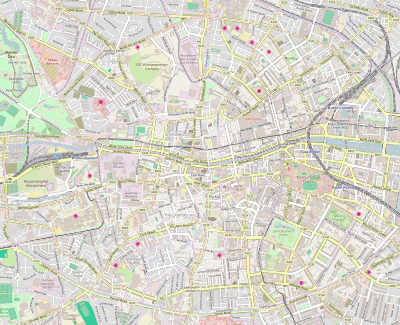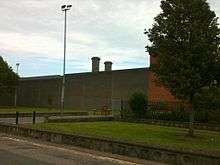Mountjoy Prison
Mountjoy Prison (Irish: Príosún Mhuinseo), founded as Mountjoy Gaol and nicknamed The Joy, is a medium security prison located in Phibsborough in the centre of Dublin, Ireland. It has the largest prison population in Ireland.[1] The current prison warden is Brian Murphy.
 | |
 Location in Central Dublin | |
| Location | Phibsborough, Dublin |
|---|---|
| Coordinates | 53°21′42″N 06°16′03″W |
| Status | Operational |
| Security class | Medium security |
| Capacity | 570 |
| Population | 550 (as of 2015) |
| Opened | 1850 |
| Managed by | Irish Prison Service |
| Governor | Brian Murphy |
History

Mountjoy was designed by the British military engineering officer, Captain Joshua Jebb, Royal Engineers and opened in 1850, based on the design of London's Pentonville Prison also designed by Jebb. Originally intended as the first stop for men sentenced to transportation, they would spend a period in separate confinement before being transferred to Spike Island and transported from there to Van Diemen's Land.
A total of 46 prisoners (including one woman, Annie Walsh) were executed within the walls of the prison, prior to the abolition of capital punishment. Executions were done by hanging, after which the bodies of the dead were taken down from the gallows and buried within the prison grounds in unmarked graves. The list of prisoners executed at Mountjoy Prison includes:
- Kevin Barry
- Patrick Moran
- Frank Flood
- Thomas Whelan
- Thomas Traynor
- Patrick Doyle
- Thomas Bryan
- Bernard Ryan
- Edmond Foley
- Patrick Maher.
- Rory O'Connor
- Joe McKelvey
- Liam Mellows
- Richard Barrett
- Thomas Harte
- Patrick McGrath
Annie Walsh from Limerick, who was found guilty of murdering her husband, was executed in Mountjoy prison on 5 August 1925. She remains the only woman ever executed by the Irish State which was founded in 1922.
After being convicted of murdering a Garda officer, Charlie Kerins, former Chief of Staff to the Anti-Treaty IRA, was hanged at Mountjoy Prison on 1 December 1944.
The last execution carried out in the Republic of Ireland, that of Michael Manning, took place in Mountjoy Prison on 20 April 1954.
Some Irish leaders involved with the Irish War of Independence and Irish Civil War were held there. On 14 May 1921, an IRA team led by Paddy Daly and Emmet Dalton mounted an attempt to rescue Sean McEoin from the prison. They used a captured armoured car to gain access to Mountjoy, but were discovered and had to shoot their way out.
The Fenian poet, author of the popular song "Rising of the Moon", John Keegan 'Leo' Casey was imprisoned here during the 1860s; subsequently in the 20th century playwright and IRA activist Brendan Behan was also gaoled within.
On 31 October 1973, it was the scene of a spectacular escape by a hijacked helicopter by three Provisional Irish Republican Army prisoners, including Seamus Twomey and J.B O'Hagan.[2]
By 2006, a 60-hectare site had been acquired for €30 million at Thornton Hall, Fingal, where a replacement for Mountjoy was to be constructed. The new facility was intended to accommodate 1,400 prisoners. The site was planned to include court facilities, video-conference links, medical and therapeutic facilities,[3] but due to government cutbacks these plans have now been sidelined.
Violence
In August 2006, prisoners who were normally separated from the rest of the population for safety were mixed together for a night with mentally ill inmate Stephen Egan. Prisoner Gary Douche was killed by Egan who was found not guilty of murder due to a lack of responsibility.[4] This prompted the Minister of Justice to seek a limit of 520 inmates on the capacity of the prison.
In October 2010, the prison was placed under lockdown after a night of violence and rioting involving more than 70 inmates. It started when a number of prisoners attacked three prison officers with pool cues and balls during recreation.[5] Reinforcements were brought in from around Dublin to quell the riot and a number of Alsatians from the riot unit were also deployed.
In 2016, figures were released showing that Mountjoy Prison saw a disproportionate number of prisoners hospitalised due to assaults and self-harm.[6] In response, the Irish Penal Reform Trust said the "ongoing levels of violence and intimidation in Irish prisons, particularly in Mountjoy Prison, must be addressed".[7]
Composition
Main Prison
Mountjoy Prison is constructed along a radial design with four main wings, A through D, each of which have three landings, as well as an underground basement landing. The wings are connected to a central circle, known simply as 'the circle'. When originally built in 1850 it had 500 cells each of which was designed for single capacity. Many parts of the original building have either been renovated or destroyed.[8] At the time of the 2009 inspection, there were 371 cells in the main unit of the prison. These are the original cells which were built in 1850 for single occupancy. Their size varies from 3.91m x 2.06m to 3.43m x 2.06m. The prison was built with in-cell sanitation but this was removed in 1939 when it was deemed that 'prisoners were using too much water'. However, all cells in the main jail have in-cell sanitation following refurbishment in the period 2010 to 2015. These cells contain a toilet, a sink, a television and a small kettle.[8]
Facilities in the prison include gymnasiums, computer classes, carpentry, masonry and a wide variety of school activities such as music, drama and cookery. Prisoners can undertake to complete academic exams in the school such as Junior Certificate, Leaving Certificate and even Open University. Additionally, there is an on-site kitchen and bakery where trusted inmates are given employment under supervision.
Medical Unit
The Medical Unit, otherwise referred to as the drug detoxification unit, is a three storied structure. It provides accommodation for sixty prisoners in forty-eight single person cells and three cells that can accommodate up to four people. All the cells in this unit have in-cell sanitation facilities. It is equipped with medical facilities, classrooms and kitchen facilities. The Inspector of Prisons reported in 2009 that this unit was bright and clean and did not suffer from overcrowding.[1][8]
Controlled Behavioural Unit
The Controlled Behavioural Unit, known as the CBU or the Block, is used for unruly prisoners or those on punishment and is located in the 'D' Base, underneath the D wing. This includes 24-hour lock-up, with the exception of one hour of open air exercise, and no integration with other inmates.[9]
Separation Unit
The Separation Unit had 35 cells. It also had kitchen facilities a shower block and a laundry. In the late 1980s, inmates diagnosed with HIV or AIDS were housed in the separation unit.[10] This policy was brought to an end on 1 January 1995.[11] Following the unit's refurbishment in 1997, all cells had in-cell sanitation.[8] The separation unit was closed indefinitely in 2014 following an inspection by the Inspector of Prisons.[12]
Mountjoy Campus
The Mountjoy Campus is home to three other separate penal facilities.
People associated with Mountjoy
A former governor was Charles Arthur Munro, brother of the Edwardian satirist Saki.[13]
The schizophrenic French surrealist playwright Antonin Artaud was briefly detained in Mountjoy before his deportation from Ireland as "a destitute and undesirable alien".
Thomas Ashe was also a former inmate of the jail for his involvement in the Easter rising 1916. After a protest of starvation he was transferred across the street to the Mater Misericordiae Hospital on 25 September 1916 where he died a few hours after arrival.
Bibliography
Carey, Tim : Mountjoy – The Story of a Prison :The Collins Press : 2000 : ISBN 1-898256-89-6
See also
- Prisons in Ireland
- Loughan House, a low security open centre in Co. Cavan also run by the Irish Prison Service.
- Kilmainham Gaol, a former prison, located in Kilmainham in Dublin, which is now a museum.
- Executions during the Irish Civil War
References
- CPT (2011). Report to the Government of Ireland on the Visit to Ireland Carried out by the European Committee for the Prevention of Torture and Inhumane or Degrading Treatment or Punishment from the 25 January to the 5 February 2010 (PDF). Strasbourg. p. 18.
- The Helicopter Prison Archived 17 December 2005 at the Wayback Machine
- "Annual Report 2006" (PDF). National Development Finance Agency. 28 June 2007. p. 10. Archived from the original (PDF) on 18 November 2007. Retrieved 17 February 2015.
- Witnesses identified in Douche inquiry, Irish Times, 23 April 2009
- "74 inmates in vicious riot at Mountjoy jail - Herald.ie". herald.ie. Retrieved 19 April 2018.
- "Irish prisoners hospitalised for assaults, self-harm and drug incidents". Irish Legal News. 9 January 2017. Retrieved 11 January 2017.
- "Hospitalisations of Mountjoy prisoners branded 'shocking'". Irish Legal News. 10 January 2017. Retrieved 11 January 2017.
- Inspector of Prisons (2009). Report on an Inspection of Mountjoy Prison (PDF). p. 8.
- Inspector of Prisons (2009). Report on an Inspection of Mountjoy Prison (PDF). p. 9.
- Annual report on prisons and places of detention: 1985. Dublin: Department of Justice. 1987. p. 43.
- O'Brien, Oonagh; Stevens, Alex (1997). A question of equivalence: a report on the implementation of international guidelines on HIV/AIDS in prisons of the European Union. London: Cranstoun Drug Services.
- "Minister Fitzgerald announces the closure of the Mountjoy Prison Separation Unit". 14 September 2014. Retrieved 11 January 2017.
- Introduction p24 of The Unbearable Saki by Sandie Byrne, Oxford University Press, 2007
External links
| Wikimedia Commons has media related to Mountjoy Prison. |
- Mountjoy Prison
- Minister announces site for new Mountjoy complex — from the official Irish Prison Service website
- Inspector-General of Prisons and Places of Detention, 3rd Annual Report – 2005
- Mountjoy Prison Visiting Committee 2004 Annual Report
- Mountjoy Prison Portraits of Irish Independence: Photograph Albums in the Thomas A. Larcom Collection